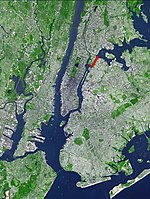Hell Gate Bridge

The Hell Gate Bridge, originally the New York Connecting Railroad Bridge or the East River Arch Bridge, is a 1,017-foot (310 m) steel through arch railroad bridge in New York City. Originally built for four tracks, the bridge currently carries two tracks of Amtrak's Northeast Corridor and one freight track across the Hell Gate, a strait of the East River, between Astoria in Queens and Randalls and Wards Islands in Manhattan. The arch across the Hell Gate is the largest of three bridges that form the Hell Gate railroad viaduct. An inverted bowstring truss bridge with four 300-foot (91.4 m) spans crosses the Little Hell Gate, a former strait that is now filled in, and a 350-foot (106.7 m) fixed truss bridge crosses the Bronx Kill, a strait now narrowed by fill. Together with approaches, the bridges are more than 17,000 feet (3.2 mi; 5.2 km) long. The designs of the Tyne Bridge in Newcastle, England and the Sydney Harbour Bridge in New South Wales, Australia were derived from the Hell Gate Bridge.
Excerpt from the Wikipedia article Hell Gate Bridge (License: CC BY-SA 3.0, Authors, Images).Hell Gate Bridge
Shore Boulevard, New York Queens County
Geographical coordinates (GPS) Address External links Nearby Places Show on map
Geographical coordinates (GPS)
| Latitude | Longitude |
|---|---|
| N 40.7824 ° | E -73.9217 ° |
Address
Hell Gate Bridge
Shore Boulevard
11102 New York, Queens County
New York, United States
Open on Google Maps










